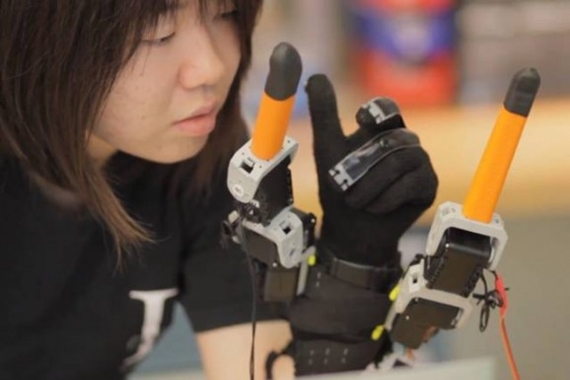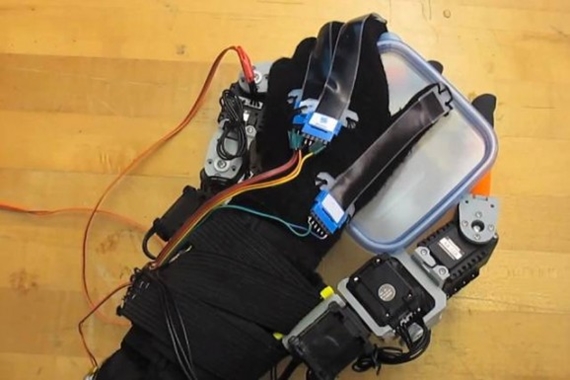Need A Hand? This Robotic Device Could Give You Two Extra Fingers

How many times have you wished you had a third hand? It’d be so convenient — you could braid someone’s hair and eat pizza at the same time, or type on the computer while playing rock, paper, scissors (provided, of course, that our brains could manage all three arms). Thus far I don’t know of any extra limb-granting exoskeletons (though surely it’s only a matter of time), but researchers at MIT have designed a robotic device that functions as two extra fingers. Seven is better than five, it turns out.
Users attach the robotic device to their wrists, where it adds two additional phalanges — one outside the pinky, and another outside the thumb. The two robotic fingers are quite a bit longer than human fingers, so they can get underneath heavier objects that might usually take two hands to lift. Just think of the range this could give piano players! I bet a human hand augmented with this thing could reach two octaves, easy. The device is controlled by an algorithm that allows it to sense and align with the user’s fingers to help them grasp and manipulate objects. Have you ever tried to put the cap back on a tube of chapstick or a bottle of water using only one hand? This happens to me while biking pretty frequently. It actually requires a lot of concentration and dexterity to hold the bottom of the object steady while twisting the top. Something like this is exactly what the two extra robotic fingers would be perfect for.

Harry Asada, MIT mechanical engineering professor, says the movements are “intuitive” and “natural” because “you do not need to command the robot, but simply move your fingers naturally. Then the robotic fingers react and assist your fingers.” In fact, they’re so easy to use that it’s possible long-term users might come to regard the robotic fingers as their own.
While the fingers themselves are likely stronger than natural human fingers, they use linked actuators to match the force of the wearer’s grip — after all, it’d be kind of weird (and probably a bit destructive) for a little old lady to have two fingers with superhuman strength. The device also responds to the type of grip the user employs — either a grasping motion or a twisting motion, or some combination of the two. When Faye Wu, a graduate student working on the project, tested it out, she found that, indeed, synergy can exist not just between our usual five fingers, but between seven fingers, even if two of them are robotic.
Further developments will include the device’s ability to sense and learn the appropriate amount of force with which to grip an object, depending not only on the user’s strength, but on the object itself (i.e., an egg versus a baseball). The researchers also want the device to be more adaptable to certain types of grips. Pretty soon, this thing will be picking our noses for us with impressive accuracy and efficiency.












